Author: Susan George
Katelyn Laidler • Derry Member
October 10, 2024The only prospect scarier than moving across the ocean is finding a new church to call home. Leaving our jobs, schools, and established life in England meant a lot of new opportunities for change. One of the most important considerations in our move was to find a church that would get us involved together as a family. Luckily, Derry has so many opportunities to feel included.
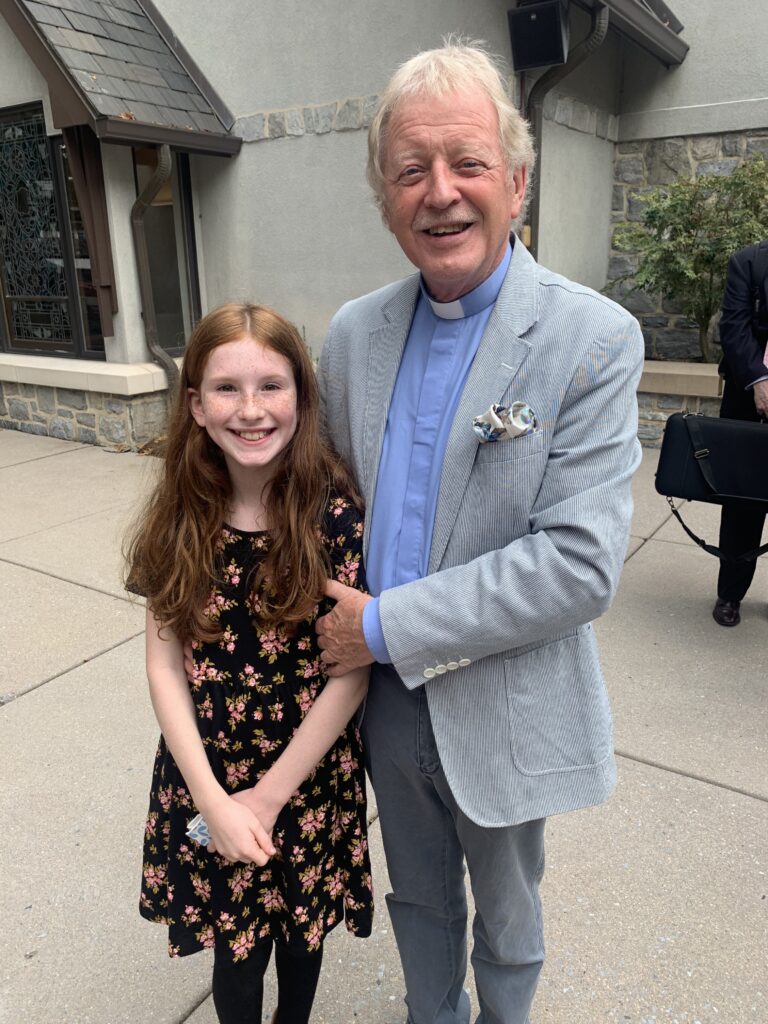
The first area we became involved in was Sunday morning Bible study where a warm cup of coffee and a safe place to have deep conversations was available. During this time, our daughter, Brooke began to make friendships and music with the kid’s ministry. As the weeks progressed, it soon became clear that Terrific Tuesdays were an important part of church life. Unfortunately, we had a clash on Tuesday nights with soccer practice which meant Brooke could only attend a few sessions of Tuesdays last year. Brooke was so eager to attend Terrific Tuesdays this year that we changed her soccer team to better allow us to come along regularly! To see Brooke confidently participating in the front of the church with handbells and singing is a testament to the inviting atmosphere Brooke has thrived within.
In addition to Tuesday nights, I have come along to many of the Sunday evening Journey in Prayer sessions where I have been made to feel so welcome. It has been a fantastic place to get to know many of the women at church on a deeper level. Austin has attended many of the Derry Dude’s sessions where he has been able to experience ax throwing and fellowship amongst friends and food. We attended the Corn Roast where happy memories of fishing and mini-golf were made. Vacation Bible School was a chance to invite loved ones to experience God’s love (and act as secret agents).
Coming from Britain it has been a pleasure to see the strong links of Derry Church to Ireland and Scotland. Most recently having the pleasure of meeting David Latimer made Brooke feel at “home.” She remarked that David reminded her of her grandad back in England and was delighted to get a picture with him. This connection and link to our neighbors across the pond has further cemented the sense of community we feel at Derry Church.
It has truly been a pleasure to sense the love, community, and warm welcome that has been shared with us in the last few months. Getting involved has helped us immensely in settling in. We are so excited and grateful we have found a beautiful community to worship alongside. Thank you, Derry, for making us feel welcome!
Jeannetta Politis • Executive Director, The Joshua Group
October 3, 2024Editor’s Note: On the first Thursday of each month, the eNews feature article highlights one of our mission partners. This month the focus is on The Joshua Group in Harrisburg.

On behalf of Joshua Group and the children we serve, we wish to express our sincere gratitude for your generous donation of $3,500, which will give deserving Harrisburg city children a chance at a quality education—and a brighter future.
We deeply appreciate your support for our students, as this donation aids in the efforts of the Joshua Group helping over 200 disadvantaged young people living on Allison Hill in Harrisburg trying to improve their lives through education.
Our summer program served 140 1st through 9th grade students in a seven-week program. They received breakfast and lunch each day along with academic and enrichment activities. Our students participated in nutrition classes, cooking classes, financial literacy classes, robotics demonstrations and educational field trips in addition to reading, writing and math focuses. Our 8th grade boys participated in a program with Recycle Bicycle where they learned how to build, repair, and maintain bicycles and learn how to safely ride. At the end, they were gifted their own bicycle to take home.
Our J-Crew After-School Program, which supports students from 1st grade to 12th grade, living in Harrisburg, gives access to the critically important educational support they need to have a successful academic career. Our after-school program gives our students a safe nurturing environment to be in after their school day. They get a hot meal, homework help, mentoring and unconditional love. We provide enrichment opportunities along the experiences and exposure in areas they might not have otherwise. Our younger students have enrichment activities such as art, cooking, crafts and reading. Our older high school students learn about vocational opportunities and internships and have opportunities to apply for summer work. Our seniors are taken on college visits as most of their families do not have the ability to provide that opportunity for them. Our dedicated staff and volunteers work tirelessly to ensure our students have all the tools to learn and be prepared for post-secondary education or a self-
sustaining career.
Last year, the students in our programs earned an average GPA of 3.03 and had an average attendance of 92% and a graduation/promotion rate of 100%. Your support will help ensure our students continue to thrive and so we can break the cycle of poverty through education.
Again, we are deeply appreciative of your support. Thank you for investing in our students and in this organization. Your donation enables us to continue to offer access to education to students who would not have a chance otherwise.
From the bottom of our hearts, thank you.
Rev. Stephen McKinney-Whitaker • Pastor
September 26, 2024
This year has been a whirlwind of Derry 300 events that culminated last weekend with our 300th anniversary homecoming celebration, worship, and cemetery rededication. We’ve spent the whole year remembering, reflecting, giving thanks for our heritage and the saints of Derry, and looking toward the future of Derry. We’ve traveled, we’ve sung, we’ve learned, and last weekend we gathered together.
Much could be said about our homecoming weekend, but the word I keep coming back to is love. I felt surrounded by love in the Hershey Lodge on Saturday night amid the happy reunions, boisterous laughter, and shared memories. I could tell everyone gathered loved one another, loved Derry, and loved God. We broke bread together, we reflected on our past, and we heard an important word for the future from Rev. David Latimer, about who we are called to be for God and the world. Our call is to share the love that shapes us. Derry does that by proclaiming God’s word, sharing God’s love, and practicing God’s justice together. We are deeply rooted in love, and that’s where our growth has come from over the past 300 years.
We’ve spent the majority of this year looking back, and now it’s time to look forward to our next 300 years. Our work is not done, our story is not finished, our mission is not yet complete. Our world has not yet learned to live and love well together, so we — all of us — need a place, and we need a time that reminds us what love is and what it does and how it shapes us. We need a place to remind us that we are all defined by who and how we love.
That’s what Derry is, and has been for 300 years. I hope that’s why you come, and why you volunteer, and why you give to the work of this church. You, and all the past saints of Derry, have given of their time, talent, and treasure to make Derry a place to worship, serve and belong, as well as a place to remember the love that shapes our lives. I hope you’ve found this to be that place, that needed place, for you and the world.
Entering our annual stewardship season, we can be inspired by our past, encouraged by our present, and hopeful about our future. In coming weeks we will be reflecting on what we can give so that Derry can continue to proclaim God’s word, we share God’s love and we practice God’s justice… or to say it another way, to share the love that shapes us.
I’m feeling inspired and hopeful after such a memorable and special weekend. I loved the weekend, and I love Derry, and I love each of you. Derry is a special place: it is a place of love. Thank you for all you do to ensure that Derry remains a place where love is taught, given, shared, and received.
Pam Whitenack • chair, Derry 300 Committee
September 19, 2024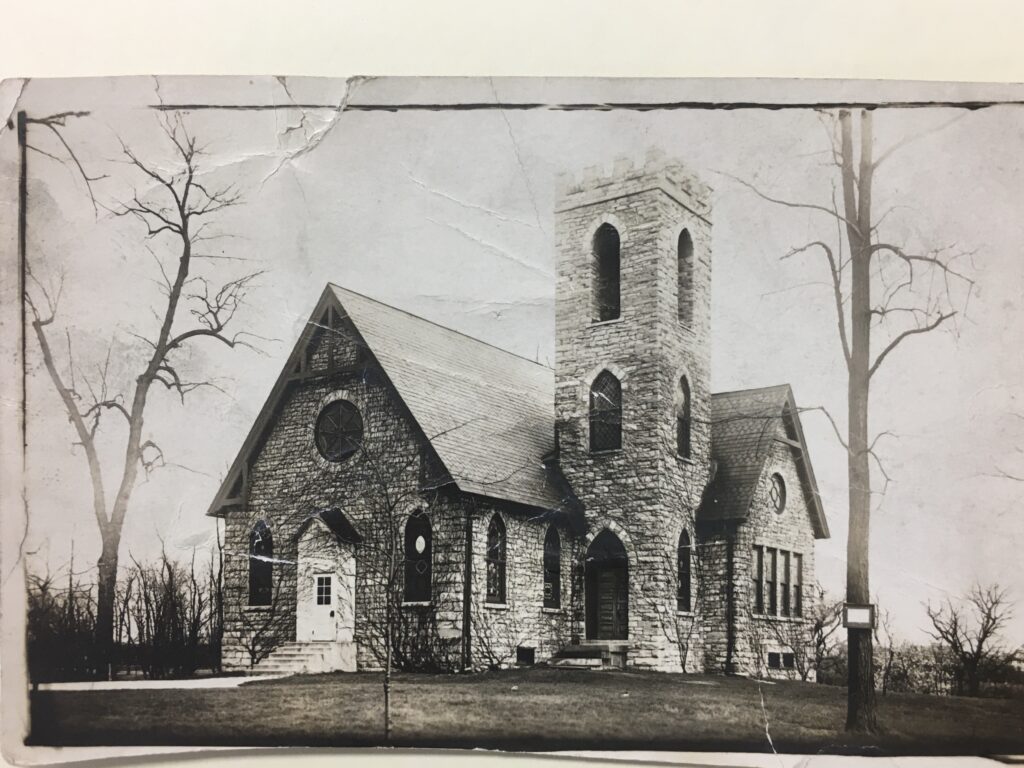
Thanks to the generosity and faith of the Presbytery and many Presbyterians, the Derry Church Chapel was completed in 1887. At the same time, Derry’s Sunday School, an organization independent of the church, was reaching and teaching many children and adults each week. While the Sunday School was expanding, without a called pastor Church membership remained static, and Derry continued to struggle financially.
While Derry Church did not have a called pastor, the church was fortunate to be served by stated supply pastors who offered Sunday evening services. Reverend Albert Williamson, pastor of Paxton Presbyterian Church, offered monthly evening services from 1885-1895, and Reverend William Groff, pastor of Middletown Presbyterian Church, led monthly evening services from 1895-1905.
Milton Hershey’s decision to build a chocolate factory and model town in 1903 had a profound effect on Derry’s future. The factory, which began operations in 1905, brought new residents to the community. Derry Church slowly began to grow in membership and financial stability.
With the continued financial support of Presbytery and with Milton Hershey’s contribution of $300 (1/3 of a minister’s salary), in 1909 Derry called its first pastor since 1874. Reverend Benjamin Segelken served Derry for only a year before taking another call. During his short time at Derry, notable changes occurred. Individual communion sets with small glasses fitting into trays were purchased, allowing the sacraments to be served in the pews. A choir was organized, a pianist was hired, and a Ladies’ Guild was established with Reverend Segelken’s wife as its first president. From this point on, Derry Church was able to continue calling full-time pastors. As the town of Hershey grew, so did the congregation.
The Ladies’ Guild played a significant role in Derry Church life. In addition to Bible studies and fellowship, fundraising played an important role in the Guild. During the Guild’s first ten years, the women raised funds to improve the Chapel building. Fundraisers were often held in downtown Hershey because there wasn’t space for such events in the Chapel. The women held Strawberry Festivals and Oyster Dinners, sold magazines such as McCall’s and Ladies’ Home Journal, sewed and sold aprons, and even offered weekly embroidery and crochet lessons to add to their treasury. With their funds, the women paid for pews in the Chapel, repaired the church walls ($150), tuned the Chapel piano, purchased a Brussels carpet ($263.75) and the church’s first electric vacuum cleaner ($20.38). In 1917, the Ladies’ Guild paid for Derry Church’s first indoor toilet.
Reverend George Snavely Rentz came to serve Derry in 1913. During Reverend Rentz’s tenure the church continued to grow in strength and numbers. The church celebrated its legacy of oak trees on November 13, 1915 by planting 50 new trees. The event was a community affair. Milton Hershey and Pennsylvania Governor Martin Brumbaugh attended and each planted an oak tree on the church grounds. The Hershey Band provided music, and Hershey Industrial School (Milton Hershey School) boys assisted with tree planting.
Reverend Rentz built relationships with other Hershey churches, holding joint worship services with the United Brethren (Hershey 1st Methodist) Church. He also reestablished summer Sunday evening lawn services.
Under his leadership, Sunday School classes continued to thrive, with the Men’s Bible class, the Christian Endeavor youth program, and women’s groups growing in numbers. Reverend Rentz left in 1916 to take a call at Market Square Presbyterian Church. When the United States entered World War I in 1917, Rentz resigned to enlist as a Navy chaplain.
Derry Church, like the rest of Hershey, sent several young men to serve in the military during World War I. And like the rest of the nation, Derry Church and the Hershey community suffered from the influenza pandemic that swept the nation as soldiers returned home. The efforts the community and Derry made to curb the spread of influenza were minimal. Once during the winter of 1919, the town shut down public schools and gatherings for two weeks. During the height of the influenza season in 1920, Derry Church suspended all gatherings besides Sunday morning worship for a couple weeks, but little else was done.
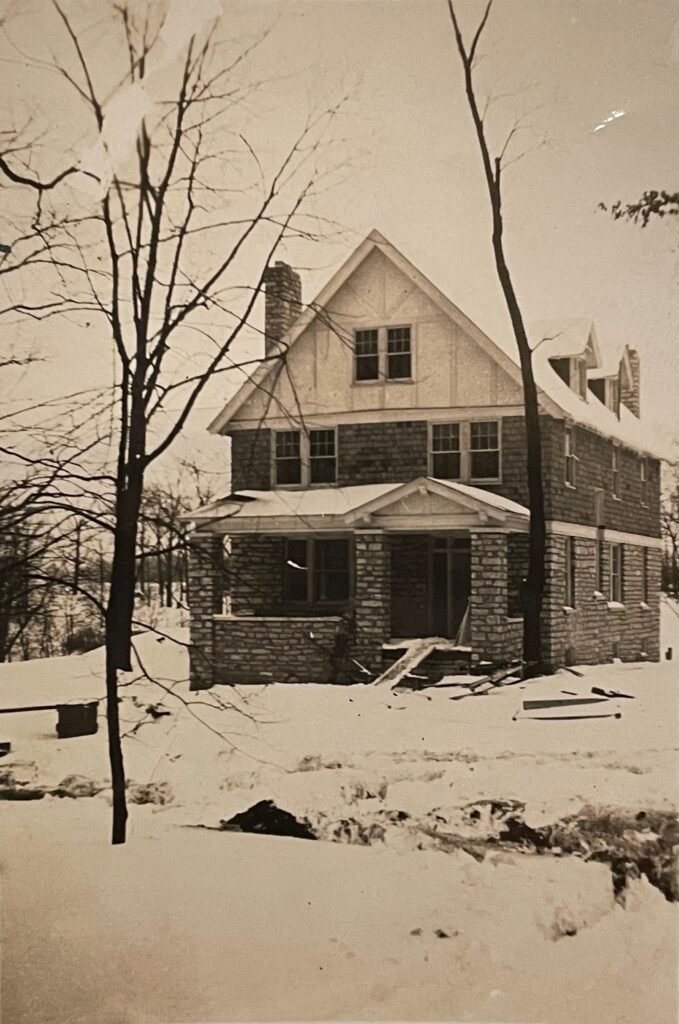
After Reverend Rentz left, Derry Church called Reverend Robert Taylor. The church rented a home located at 20 West Chocolate Avenue to serve as the Church’s manse. In 1924, Derry built a manse for the pastor’s use on church property. It was located near the corner of East Derry Road and Mansion Road, close to today’s church office entrance.
By 1924, Derry’s 200th anniversary, church membership had grown to 148 members with an average of 150 people attending Sunday School each week. The church celebrated its anniversary with several services held over one weekend. The weekend was marked by the return of former members, descendants of former pastors, and friends of Derry.
Reverend Taylor wrote a historical sketch of Derry Church that he presented during one of the services. This sketch, which Taylor later expanded, became Derry’s first published history.
Reverend Taylor’s interest in Derry’s history led to the preservation of the Session House through the construction of its glass enclosure. Reverend Taylor seized the opportunity when Milton Hershey was visiting the church property to check on the trees to ask for a donation towards preserving the Session House. That request led to Milton Hershey directing his architect-builder, D. Paul Witmer, designing and constructing the building’s glass structure.
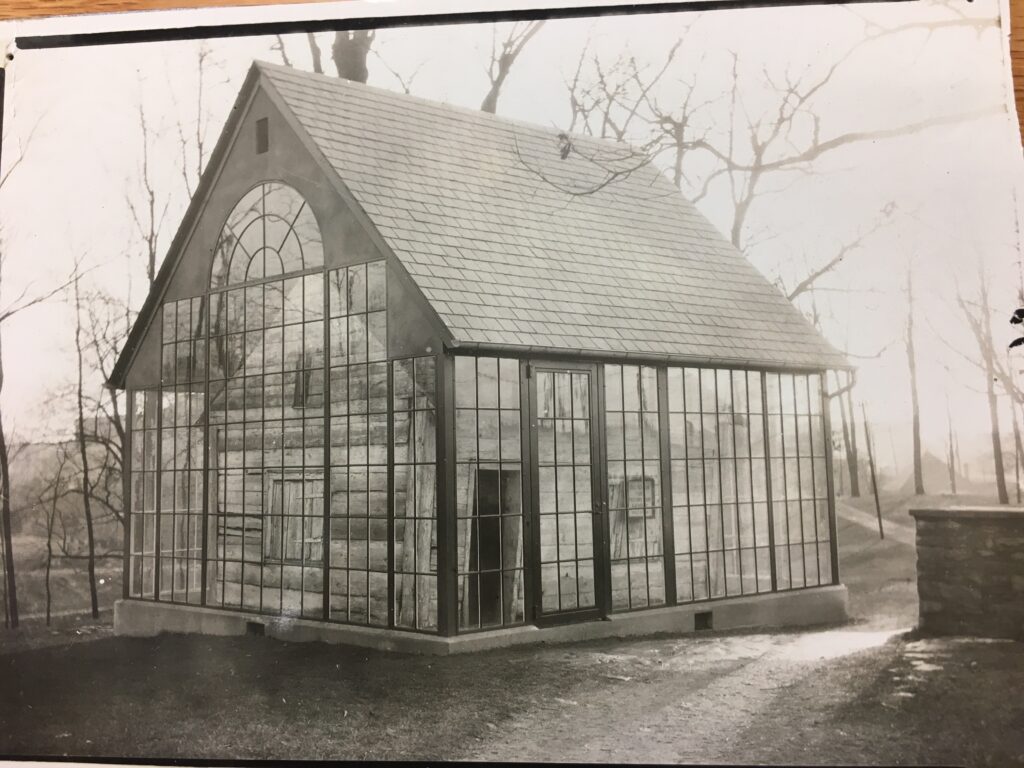
While he served as Derry’s pastor, Reverend Taylor emphasized tithing in his sermons and ministry. As a result, by 1927 Derry Church became self-supporting and no longer needed the Presbytery’s financial support.
By the mid-1920s, congregational growth led to plans to expand the Chapel. Preliminary plans showed an extension to the west of the church. However, after much discussion the final design called for the construction of an east transept to the Chapel with classrooms behind the original building and a social gathering space on the lower level. In honor of Derry’s best known former pastor, the new expanded Chapel would be christened “The John Elder Memorial Chapel.” The economic crisis resulting from the Great Depression would delay construction for several years.
Rev. Shawn Gray • Associate Pastor of Christian Education
September 12, 2024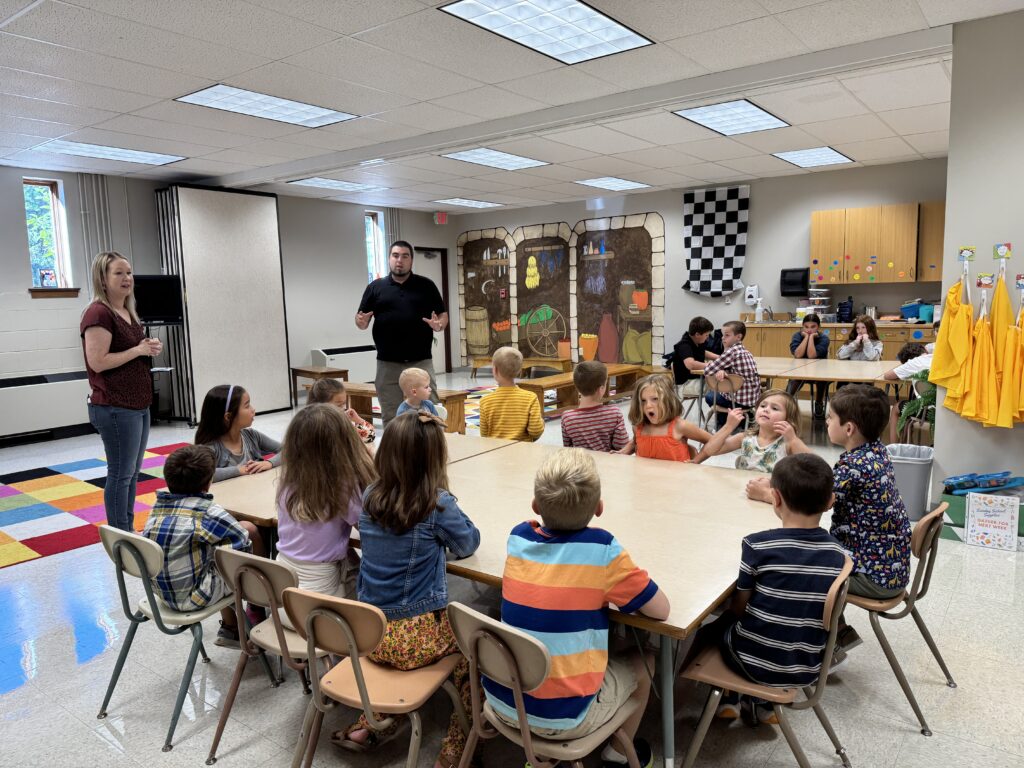
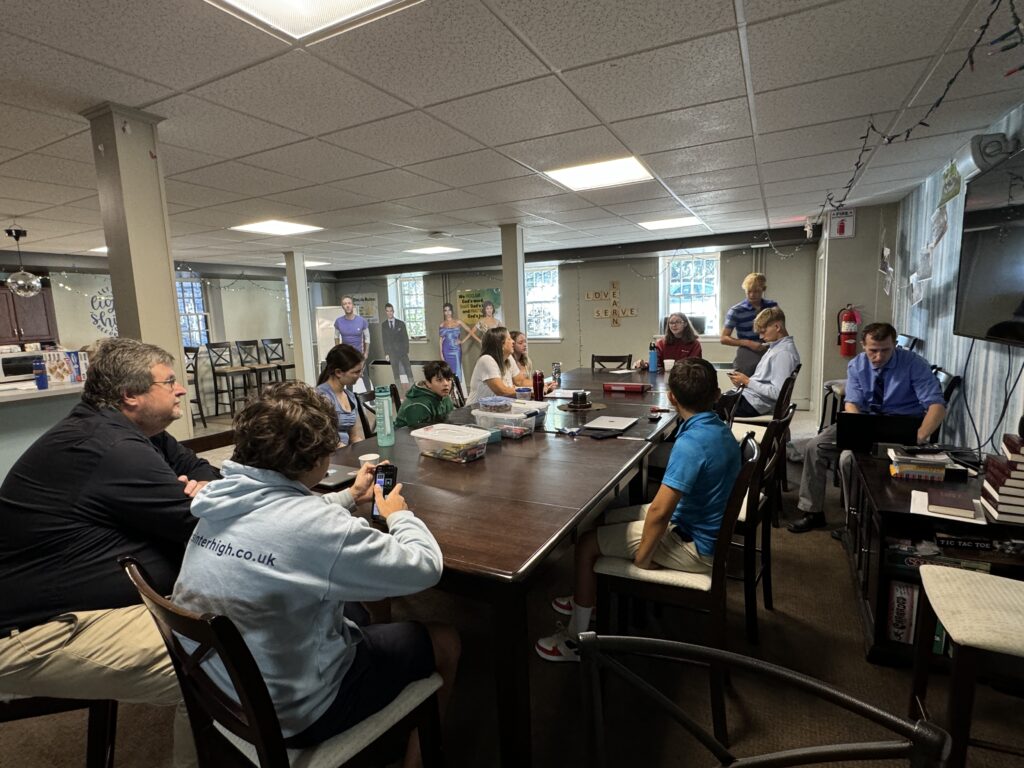
We just started our new program year, and it looks like it is going to be a great one. Our Sunday School is back in full swing, and I have been encouraged by all the volunteers — both new and experienced — who have stepped up, willing to help. They bring with them a wide spectrum of energy and gifts to make our programs even stronger.
The youth group (grades 6-12) just kicked the year off with “Cutout Capers.” At this event, the youth broke up into teams and headed into the Hershey community with life-size cutouts of celebrities such as Adam Levine (the lead singer for ColdPlay) and Katy Perry. Taylor Swift was supposed to be in attendance, but her schedule didn’t cooperate (shipping was delayed). Teams had a list of places to go to take pictures with their cut-out. Much fun was had.
The Kids Fellowship (grades 3-5) will go apple picking on Sunday, along with the youth and everyone who wants to participate in this all-church activity. Later in the fall we have planned bonfires, s’mores, corn mazes, popcorn making, and service projects.
Our Sunday School is up and running with some new tweaks. Youth started “3G” during the Sunday School hour, which stands for God, Games, and Grub. We will be playing games, then having a faith discussion surrounding those games. Some of the games will be classics like Pictionary or charades, while others will be modern like Jack Box. After we play, we will eat and talk about things that matter. We had a great turnout this past Sunday.
Grades K-5 are following the SparkHouse curriculum, which includes hands-on activities, faith discussions, and multimedia resources. This past Sunday each class created a covenant to help them promise how best to treat each other.
Terrific Tuesday started this week, and we are excited about all the music, stories, fun, and puppets that will be happening. We have simplified the schedule a bit and added a recreation block so that our kids have time just to be kids and play with each other.
Now that you know more about our programming, I would like to tell you why we offer these programs. Our primary goal is to create a safe place where all who participate will hear that they are loved by God (who is always with them) and by their church family. It has been my experience that if you are successfully able to accomplish these goals, then you can have rich discussions about faith formation, having divine worth, participating in God’s amazing work, dreaming about how the church can live its mission out, and discerning and realizing that each of us are uniquely equipped and have something to contribute to the church, community, and world.
Something that you may not always hear a pastor say but I firmly believe is that participation in the church’s programming is not a requirement to having a faith. I believe that you should make faith a priority in your life, but our programs are just one way you can support and enrich your faith. Family time, athletics, vocations, and academics are also very important and demand your time. These things also contribute to your faith.
I encourage you to make faith a priority in your life, and I hope that our programs will aid in your faith development. I hope and believe you find lifelong relationships in our church community. And I want you to remember that when life gets busy with other commitments, it’s completely understandable to take a break. Know that you will be missed, and we will be thrilled to see you when you return.
Gather the Spirit for Justice • A mission partner in harrisburg
September 5, 2024
Editor’s Note: On the first Thursday of each month, the eNews feature article highlights the mission focus for the month. In September we’re lifting up the Peace & Global Witness Offering, where a portion of funds received goes to our mission partner Gather the Spirit for Justice. In their own words, here is a snapshot of their operations:
The mission of Gather the Spirit for Justice (Gather the Spirit) is to “strengthen community in Allison Hill, Harrisburg, Pennsylvania.” Most of our neighborhood folks are low-income and many are homeless. For the census tract immediately surrounding the community center, census data shows an estimated 2020 median family income of only $35,306 and a minority population of 88%.
Gather the Spirit’s Common Ground Community Center provides a safe, comfortable place for our neighbors to gather for classes, weekly community breakfasts, gardening and special events. We offer services that help them improve their opportunities for employment and personal growth (e.g., English as a Second Language classes, cooking classes) and we assist with basic personal needs (e.g., toiletries, food, cleaning supplies).
Gather the Spirit began operation at the Shared Ministry on Market Street in Harrisburg in the 1970s and later also partnered with the Unitarian Church of Harrisburg, The open door of the community center was closed during the worst part of the Covid pandemic, from March 2020 through 2022. Now Gather the Spirit is located on the bottom floor of Christ Lutheran Church in Harrisburg, and Common Ground Coffee can be found there every Saturday, 9-11 am.
Dear Derry members, The Mission & Peace Committee would love to interest you in some of Gather the Spirit for Justice’s volunteer opportunities and the committee hopes to offer some financial support after taking a hiatus during the Covid pandemic. Please consider supporting this worthwhile mission! Contact me for more information and to volunteer — Karen Leader, Mission & Peace Committee Member
Dan Dorty • Director of Music and Organist
August 29, 2024A Musical Note
The Sanctuary Choir and Derry Ringers performed to over 300 people at Mount Gretna on Sunday, August 4. The concert was extremely well received, and my deepest gratitude goes to each musician who sang and rang with passion and artistry. Derry Church was well represented, and the presence of the Holy Spirit was felt in that sacred place.
Sanctuary Choir rehearsals for its fall 2024 season have begun! Save the date for the 2024 Christmas at Derry concert, set for Sunday, December 8. The concert will be at 3 pm, followed by a reception in Fellowship Hall. The youth will provide gourmet popcorn at the reception.
Derry Ringers will begin rehearsals on September 10. Claire Folts and Debbi Kees-Folts are completing a fall schedule for the children and have worked out dates for singing in worship.
A Programming Note
Our 2024 Arts Alive season is well underway, and we are also finalizing plans for the 2025 season. Here’s what you can look forward to in the months ahead:
- October 6: Pianist Thomas Pandolfi returns to play a concert on the Lee Ann Taylor Memorial Steinway
- November 3: Silver, Wood, and Ivory
- December 8: Christmas at Derry, one concert at 3 pm in the Sanctuary
My deepest gratitude to Dick Hann and the Arts Alive committee for their tireless work in preparing for this upcoming season.
A Note on Organ Tuning
When the Aeolian-Skinner organ, Opus 1132, was installed, A-Thompson Allen included ten tunings within the removal, refurbishment, and reinstallation contract. When those tunings were completed, the subsequent tuning cost was $1,800 (which included travel and lodging). Seeing that this amount was not reasonable as there are so many qualified and skilled technicians in our area, I sought the services of a local tuner and technician. The work carried out on March 8 was unsatisfactory as the organ had temperament discrepancies throughout several divisions, and maintenance issues were not resolved as requested.
I am happy to report that on Friday, August 9, Steven Emery, a highly respected tuner, rebuilder, and technician, came to tune our organ, fixing every issue previously mentioned, and the organ is playing and sounding better than ever. The cost for Steve’s work was roughly half that of A-Thompson Allen’s, and his work is exceptional. Steve is the curator of organs at many esteemed institutions, including St. Bartholomew’s in New York City and the Wanamaker Organ in Philadelphia, and is currently working on the complete refurbishment of the National Cathedral Organ. His skill and artistry bless us at such a reasonable cost.
A Note of Thanks
Sarah and I would like to thank the members of Derry Church, the Session, and Pastor Stephen for all your love, care, and support of our recent wedding in June. We are blessed to now live in the Hershey area and be 10 minutes from Derry Church, which was made possible by the generous support of the congregation of Derry Church. Now that I am fully recovered from Covid, I look forward to an exciting season ahead.
Beckie Freiberg, BSN RN CPN FCN • Faith Community Nurse
August 22, 2024
It has been over a year since I had the privilege of becoming Derry’s first Faith Community Nurse, and what a year it has been. I have been so welcomed by all of you and for that I am grateful. Derry truly is a special place.
In November, I completed a 16-week online Faith Community Nurse Course from West Virginia University College of Nursing. The course dealt with all aspects of Faith Community Nursing. I learned so much, including much about myself, through the readings and online discussion with my classmates and instructors. Upon completing this class, I am officially a Faith Community Nurse and can use the FCN title.
As an FCN, I am tasked with the care of our church community through knowledge of the body, mind and spirit. Let me share with you what I have been doing for Derry over the past year:
- I visit members who are hospitalized (20 visits), at home (13 visits), and in long term care facilities (16 visits).
- I contact members when they have had surgery or are ill at home. Well over 100 of you have received at least one phone call, email or text from me. I answer medical questions and have made many referrals from my list of health resources. Many of you have called me or dropped by my desk at church to chat or to receive advice.
- I take part in worship services at Londonderry Village and help lead the Prime Timers programs.
- Education is a priority. There are now eight Health Time with Nurse Beckie presentations available on the church’s YouTube channel, including subjects such as diabetes, heart health, home safety, advance directives, and health maintenance and screenings.
- This past spring, we presented “A Matter of Balance,” a class led by Amy Bollinger, RN from the Penn State Health Trauma Team. The eight-week class instructed participants on staying safe from falls, including exercises for increasing strength, flexibility, and balance. The class was so well received that we are holding another class beginning October 8: contact me if you’d like to attend.
- We offered the “Safe Sitters” program through the Penn State Pediatric Trauma Team this summer. The 20 teenage participants received instruction on child care, choking rescue, how to stay safe in a home, and who and when to call for help. If you are in need of a sitter, call the church office for names of available graduates.
- I am a member of our Health and Wellness Team. We are an active group and among our many initiatives is a new Wellness Connection Group that promotes fellowship through physical activity.
- I serve as a resource for the Disability, Inclusion, and Accessibility Committee, which has instituted several programs and initiatives to better serve all who enter this church.
- I am a substitute co-leader for Derry’s GriefShare support group.
- We now have three AEDs, checked monthly to assure the operation of the devices. The AEDs are located outside Fellowship Hall, outside the Hammond Library, and outside Room 5 on the lower level. First aid kits are located on the wall outside the kitchen, in the kitchen, above the AED by Fellowship Hall, in the closet outside the Sanctuary, by the entrance to the office, and in the office.
- I have had the privilege of serving as liturgist in worship services and at funerals.
In July, my husband and I traveled to Lusaka, Zambia, where I was able to visit the family of Cecilia Kangwa, pictured above. Cecilia attended Derry Church and passed away in February. It was such a meaningful experience to reconnect with Cecilia’s mother Grace, meet her family and accept their hospitality. Grace was so thankful that we were able to visit her in her home so far away, and to grieve her loss as someone who was there with her at her most difficult time.
This year has been one of learning and experience, and it is my honor to serve the people of Derry as your Faith Community Nurse. I am blessed with this unique nursing ministry.
Derry Church Seeks Finance Director
August 21, 2024As the retirement of Sandy Miceli approaches, Derry Church is in the process of searching for a skilled and experienced Director of Finance as her replacement. The ideal candidate will be responsible for overseeing all financial aspects of our church organization and ensuring the church’s financial health. Read more.
Pam Whitenack • Chair, Derry 300 Committee
August 15, 2024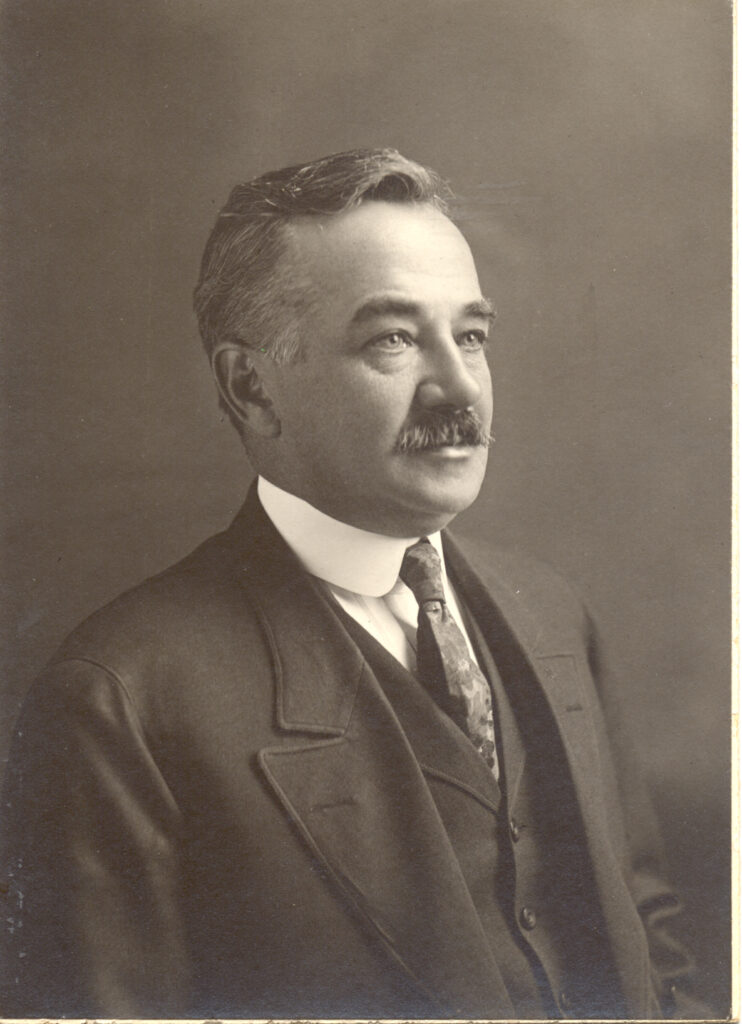
In 1894 Milton Hershey established the Hershey Chocolate Company in Lancaster, Pennsylvania as a subsidiary of his highly successful Lancaster Caramel Company. The chocolate business grew quickly, and he soon needed to build a new, larger factory for his company. He looked up and down the Eastern seaboard for the best location, and in 1903 he selected a site near Derry Church. Milton Hershey envisioned building not just a factory but also a model industrial town for his workers.
Milton Hershey’s construction of the chocolate factory and his decision to build a model town would have a significant and beneficial impact on Derry Presbyterian Church.
After the Chapel was completed in 1887, Derry Church continued to struggle. In 1900, membership was only about 12 people. Derry did not have the financial resources to call a pastor. Instead, Derry continued to be served by stated supply ministers, including Reverend John Groff (1895-1905), who offered a Sunday evening service each week. Reverend Groff was the pastor for Middletown Presbyterian Church during these years.
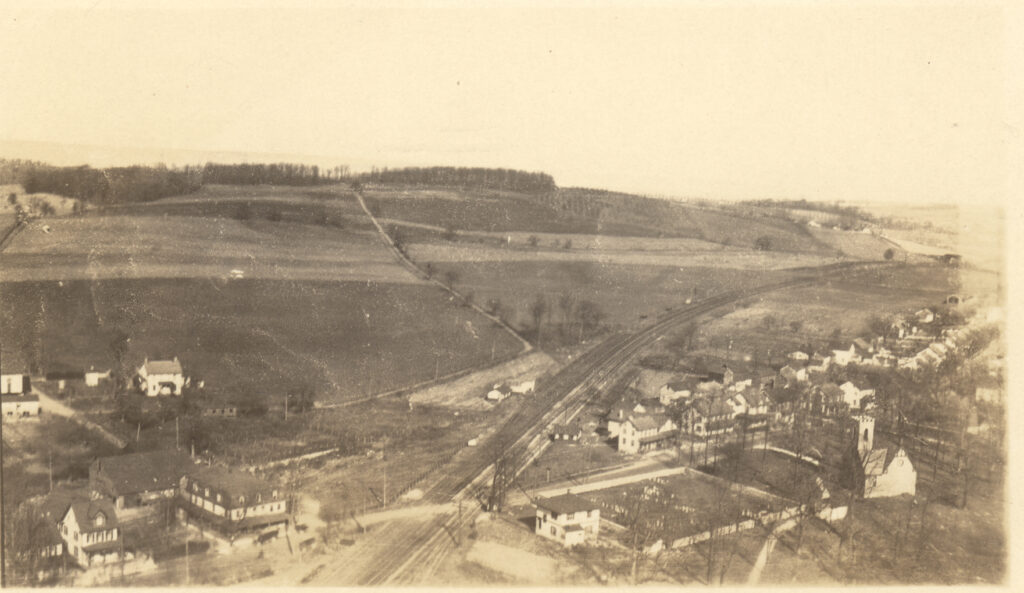
When Milton Hershey came to this area, he needed fresh water for his chocolate factory and approached Derry Church to rent the Derry Church spring. The church session agreed, and in 1903 a ten-year lease was signed at the rate of $75 a year. To manage the water flow, Hershey installed a pump at the spring and ran a line to the factory. The pump was enclosed by a shed. Hershey Chocolate Company continued to rent the spring until 1928 when Derry Church sold the land on which the spring was located to Milton Hershey to be part of the new Hershey Country Club golf course.
It wasn’t until 1909 that Derry Church was able to call its first pastor in decades, Reverend Benjamin Segelken. Milton Hershey donated one-third of Rev. Segelken’s salary, $300, to Derry that year. Carlisle Presbytery also provided financial support to the slowly growing congregation.
Milton Hershey provided financial support to Derry Church for several more years. In addition, Milton Hershey agreed to maintain the church grounds, providing funds for lawn mowing, snow removal, and maintaining the paths that connected Derry to the new community.
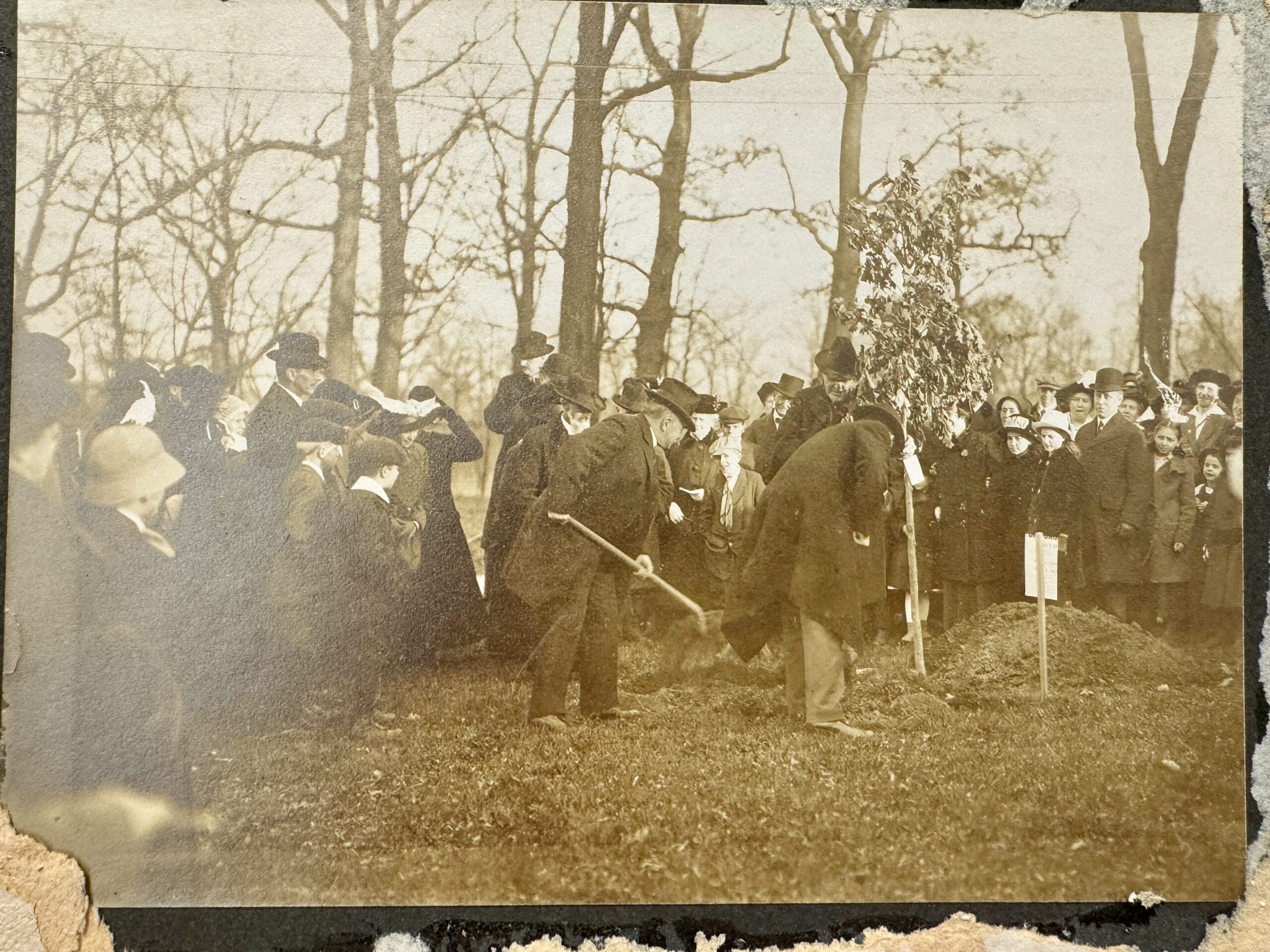
As the Hershey community expanded, Derry Church continued to play an important part in town events. In 1915 Derry Church celebrated Arbor Day by planting 50 trees. It was a major event, not just for Derry but for the entire town of Hershey. Hundreds of people attended. Honored guests included Pennsylvania Governor M.G. Brumbaugh and Milton Hershey. Two trees from that 1915 planting are still part of the church grounds. A Scarlet Oak stands near the rear entrance to the Sanctuary and a Laurel Oak can be found near the Chapel walkway.
The growth of the Hershey community brought new members to Derry Church. Between 1900 and 1930, Derry’s congregation grew from 12 to 150 members. By 1928, Derry had become self-supporting and no longer needed financial support from Presbytery.
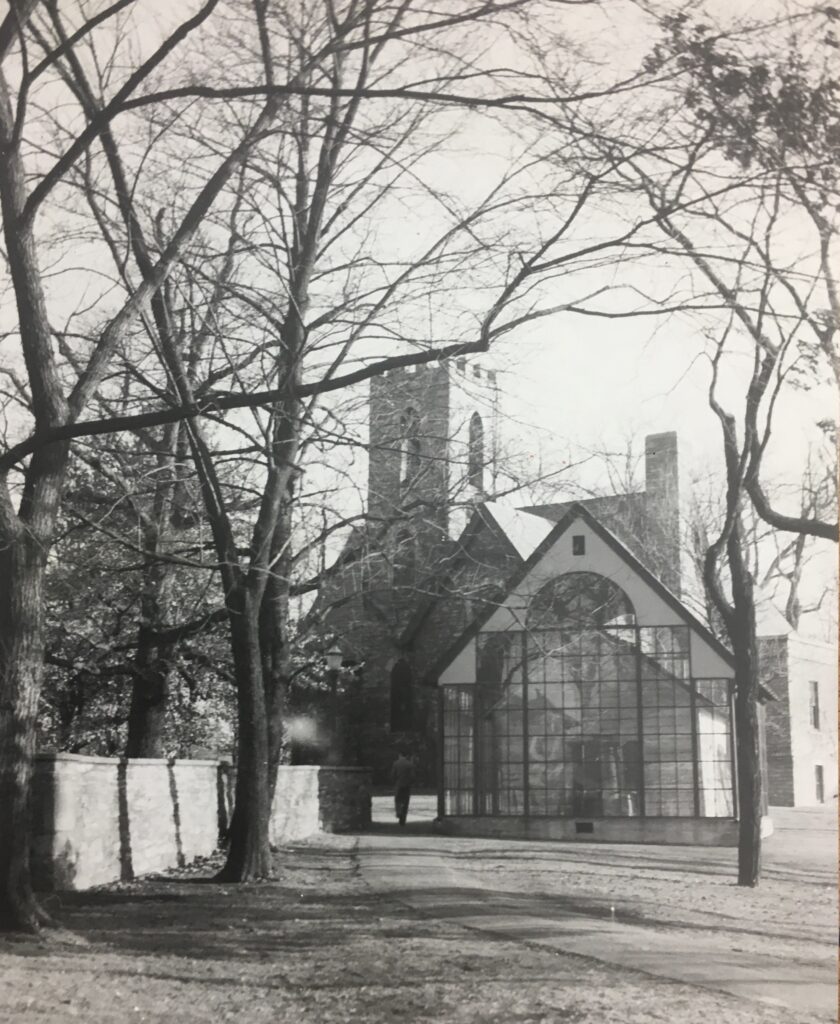
The following year, Milton Hershey once again came to the aid of Derry Church. The Session House was known to be the oldest structure in Derry Township. The church was proud of the Session House and the role it had played in the church’s history. At that time the church was concerned about the preservation of the building. One day Milton Hershey and Harry Erdman, manager of the Hershey Nursery, came to the church grounds to look at some of the old trees to see if any needed care. Reverend Robert Taylor (1916-1932) came out to greet them. He asked Milton Hershey for a contribution towards the preservation of the Session House. Harry Erdman told this story in an 1955 oral history interview:
Mr. Hershey said, “Well, what’s it going to cost?”
Well, he [Reverend Taylor] didn’t have any idea. He thought $5,000 – $10,000.
Mr. Hershey said, “Well, I’ve seen a building like that over in France somewhere. I don’t recall just where it was. They had the whole thing enclosed in glass. I’ll get our architect here and see what we can do about it. We won’t give it to the Historical Society. Now is there anything else you can think of?
“No,” he [Reverend Taylor] said. “I appreciate that very much, Mr. Hershey.”
Mr. Hershey said to me [Harry Erdman] “You’ll talk to him and let me know.”
He said, “We’ll take of it. Now, come on, Erdman, let’s get out of here before we get stuck for something else.”
That year Derry Church was also making plans to expand the Chapel to add additional classroom and fellowship space. Plans were drawn up, but with the onset of the Great Depression it was uncertain if and when Derry would be able to restart the expansion project. However, in October 1934, Harrisburg philanthropist Henry B. McCormick (1869-1941) approached Reverend John Corbin with an offer of a major donation ($5,000) to help underwrite the cost of the expansion plan. The McCormick family were members of Pine Street Presbyterian Church and long-time supporters of Derry. His father, Colonel Henry McCormick (1831-1900), was one of the members of the Harrisburg Historical Society who helped raise funds for the construction of the 1884 Chapel.
In addition to Mr. McCormick’s gift, the church also received $2,000 from Milton Hershey.
Construction was nearing completion when on July 4, 1935, Milton Hershey gifted each of the Hershey community’s five churches $20,000 (Derry, Hershey First Methodist, Spring Creek Church of the Brethren, St. Joan of Arc, and Holy Trinity Lutheran). The gift helped many churches cover financial shortfalls resulting from the Great Depression. Derry Church used Mr. Hershey’s unexpected gift to expand the construction project, adding a vestibule to the Chapel entrance and new chancel furniture and architectural elements. The church also installed new carpet and purchased furniture and equipment for the new classrooms.
This unexpected gift also created an opportunity for Derry to establish a strong financial foundation. In the 1936 Annual Report, the church’s Board of Trustees shared this report:
The Year just closed has been a Happy and uneventful one to your Trustees, as with the full cooperation of the Congregation and the various organizations of the Church, they have been able to pay all bills promptly, paint the Manse, install a new fire door at the entrance to the Boiler Room, include liability insurance as a protection to the Church employees and close the year with out a penny of debt, all bills paid, and a comfortable balance in the Bank. In addition to this the congregation has an invested nest egg of $11,000 of U.S. Government bonds.
F.C. Snavely, Chairman
This $11,000 investment came from the balance of Mr. Hershey’s unexpected gift.
Milton Hershey never joined any of the churches in Hershey. It was said that he would attend each church occasionally, generally sitting in the back and leaving as worship ended. His commitment to the community he established extended to the churches that served the residents. When Milton Hershey died, his funeral was held at the Milton Hershey School Senior Hall. All of Hershey’s churches were represented at the funeral service, including Reverend William Longbrake (1941-1950).
Kathy Yingst • Administrative Assistant and Clerk of Session
August 8, 2024Throughout the summer, the theme for our Sunday sermons has been “That’s My Question!” I would venture to guess that at some point when you have arrived at Derry to attend a meeting or other event, your question has been, “Why is the door locked when I need to enter the building?”
Gone are the days when church doors were open 24/7 and no one worried about security or unauthorized entry into the building. Recently, Derry’s Session reinstituted a policy that we had prior to COVID – that of locking all church doors, except the courtyard door, on a Sunday morning from 10:40 – 11:30 am. While we have had no threat or security breach, the Session thought it would be a prudent step to bring back this small but important step.
However, this practice is not the full story when it comes to the church doors. Derry is a busy place with daily meetings, musical performances, Derry Discovery Days, Zumba, and other events. A PA Department of Human Services rule requires that the doors must be locked when Derry Discovery Days preschool is in session and students are in the building. During that time, the best place to enter the building is door #1 on the Mansion Road side of the building. There you can use the intercom located on the left-hand wall to contact me in the office, and I will electronically open the door for you.
The doors are controlled by a computerized security program in which all doors remain locked unless they are set to open and close at specific times. While this program is controlled by a few staff members, including me, your help is critical in setting the doors correctly. If you oversee an event that is scheduled for the building, give me a call in the office and let me know when you would like to have the doors open and close. Many times, I simply guess on what is appropriate. Sometimes the times I choose work, but other times they don’t.
The doors will open and close precisely at the time programmed. If you arrive early, realize that the door will only open at the time set in the program. If the light is red on the keypad by the door, the door is locked. A green light indicates the door is open.
Finally, the doors should never be propped open. Doing so negates any security feature. Also, it allows entry to any number of our outside friends: squirrels, chipmunks, snakes, birds, and bats. Believe me, we’ve seen them all!
Keeping the church building safe, secure, and uninhabited by local wildlife is a job for each one of us. Call the church office any time Monday thru Friday, 8:30 am – 4:30 pm to report the times you would like to have the doors open for your event.
Arnold Taylor • Director of Programs, Boys & Girls Club of harrisburg
August 6, 2024Editor’s Note: On the first Thursday of each month (or close to it), the eNews feature article highlights the mission focus for the month. In August we’re lifting up Education of Children and our mission partner, the Boys & Girls Club of Harrisburg.

The Boys & Girls Club of Harrisburg has been a safe, positive place for kids since it opened its doors back in 1939. Although it has only been close to 100 years, the Boys & Girls club has served numerous generations of families in Harrisburg and its surrounding areas. What started as a recreational center for young males under the name “The Boys Club” has since blossomed into an activity and educational based program serving members from ages 6 to 18.
Career exploration, homework tutoring, trades, the arts, esports, athletic leagues, and most importantly, service to the community are a few programs offered to our members at the Boys & Girls Club of Harrisburg, which mirror what is done nationwide at other Boys & Girls Clubs. We also offer programming that is unique to our location. During our 2024 summer camp we partnered with a former club member who now owns his own therapy practice to discuss with our members the importance of understanding mental health. We have also partnered with several agriculture programs throughout the city which has allowed us to maintain our own garden at our main clubhouse. Having our own garden has allowed us to teach our members how to grow healthy alternatives and promote a healthy lifestyle.
The Boys & Girls Club is also a place for exploring and having fun during the summertime. We pride ourselves on providing our members with a fun and captivating summer experience all members want while off school. While planning for our summer, we make sure to schedule both familiar and new and exciting fieldtrips that our members will enjoy and remember for years to come. Whether it’s a swimming trip to our local pool or a trip to Baltimore to Top Golf we are positive that our members will create lasting summer memories with their peers.